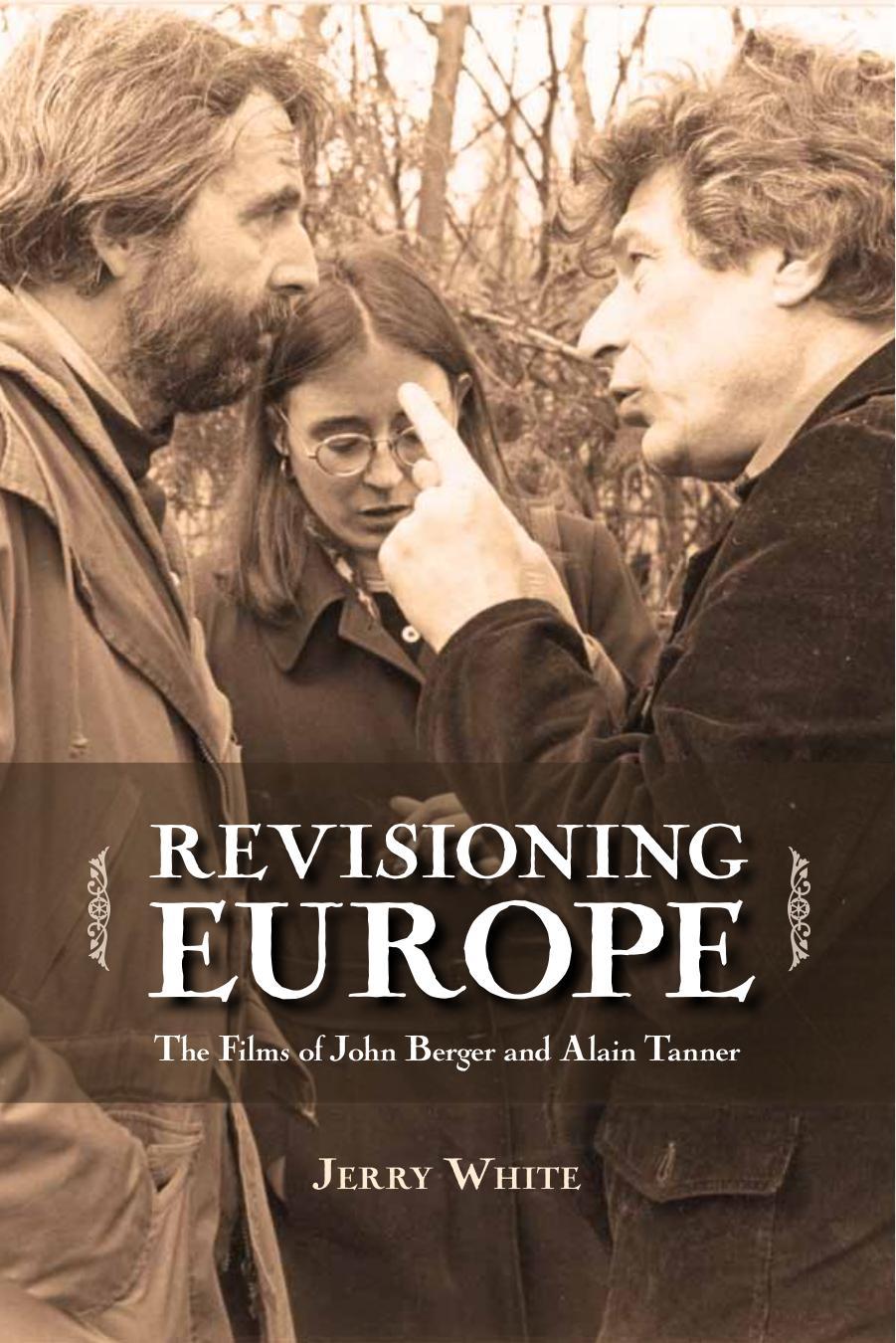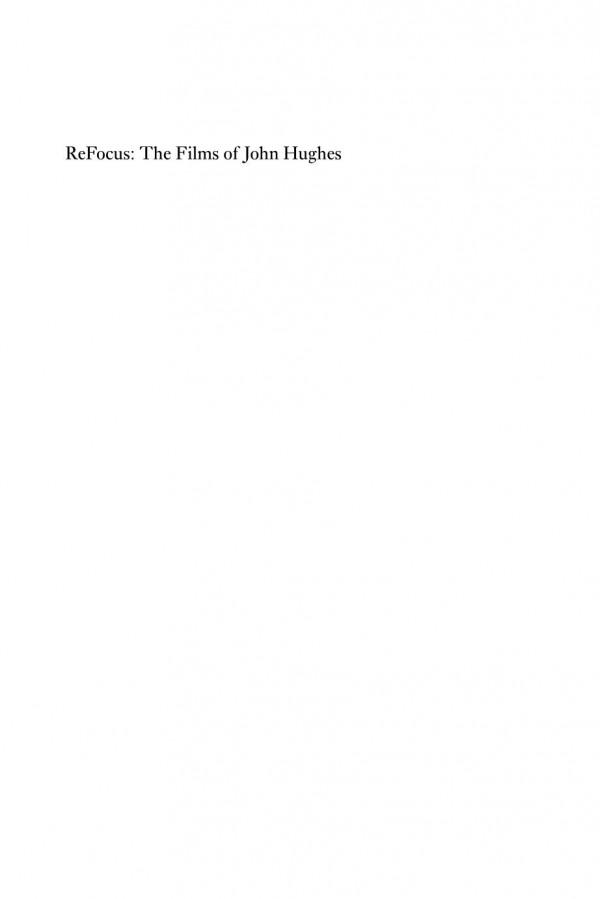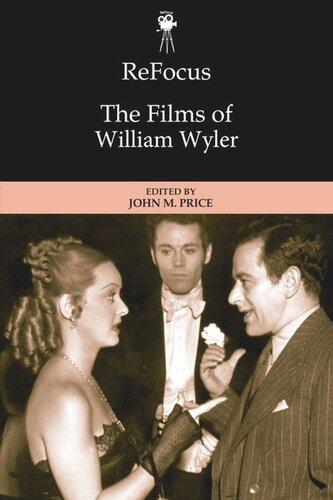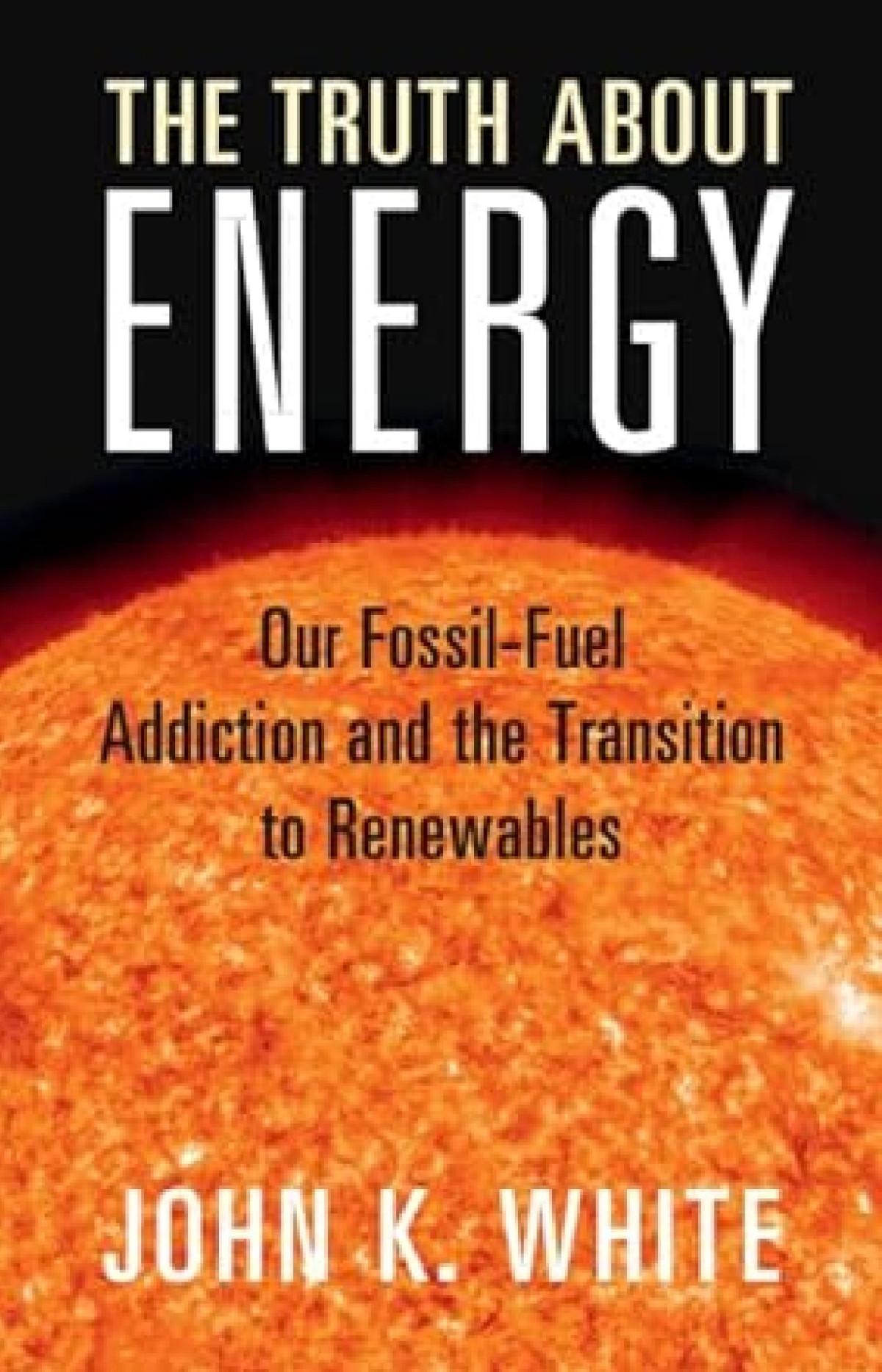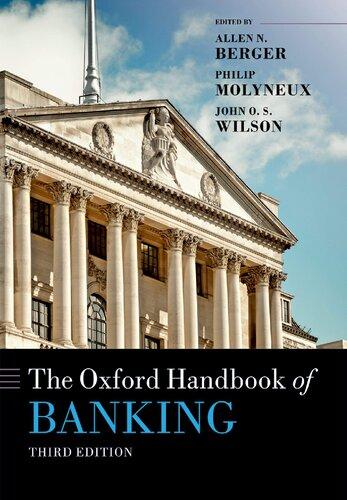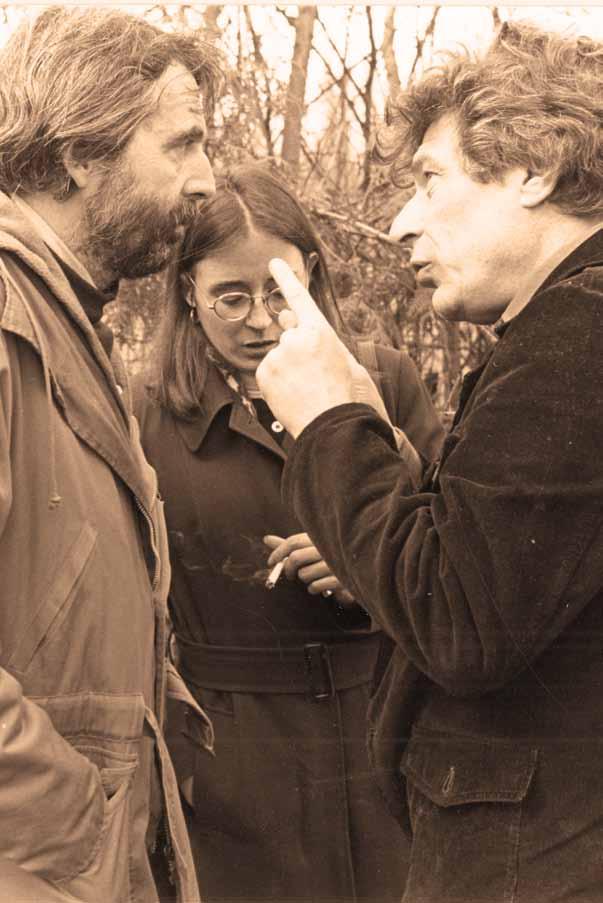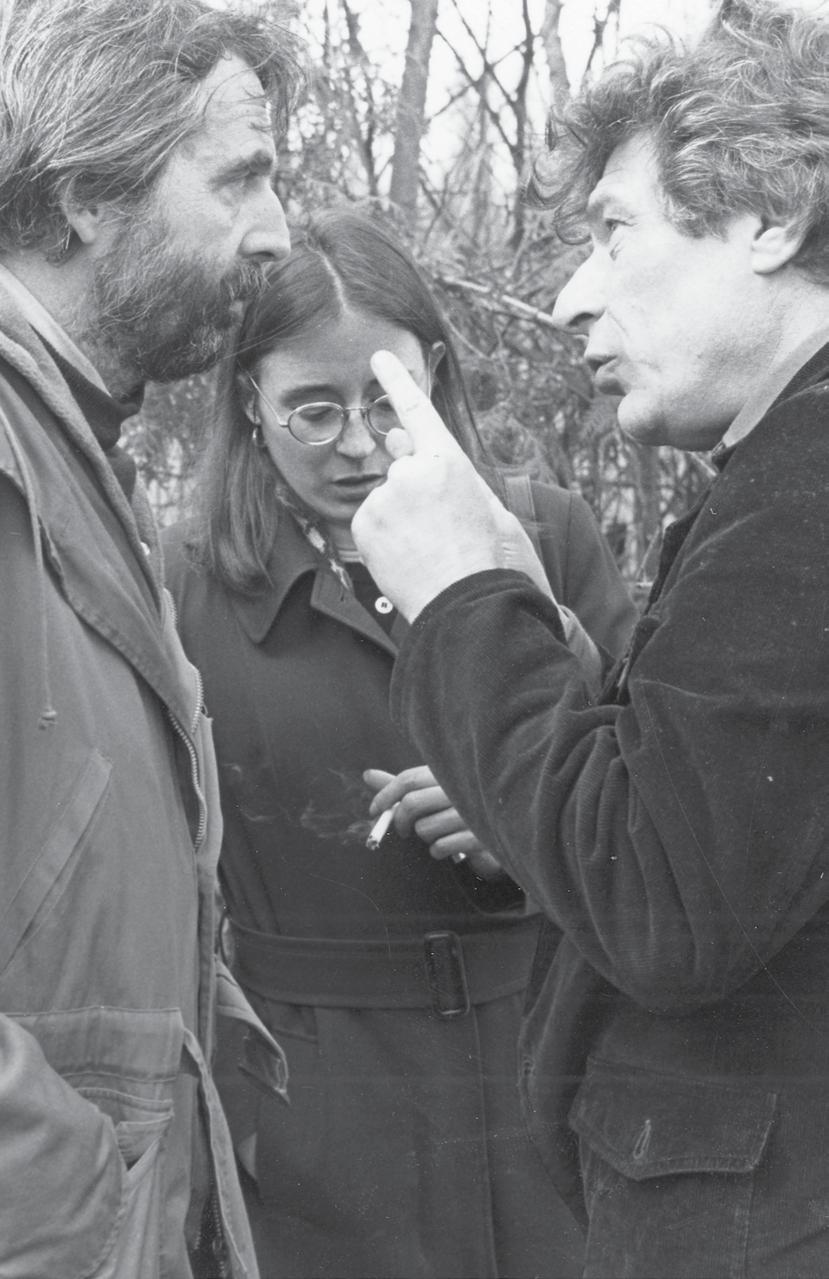Revisioning euRope
The Films of John Berger and Alain Tanner
Jerry White
© 2011 Jerry White
University of Calgary Press 2500 University Drive n W Calgary, a lberta Canada t 2n 1n4 www.uofcpress.com
no part of this publication may be reproduced, stored in a retrieval system or transmitted, in any form or by any means, without the prior written consent of the publisher.
Library and a rchives Canada Cataloguing in Publication
White, Jerry, 1971revisioning europe [electronic resource] : the films of John Berger and a lain tanner / Jerry White.
(Cinemas off centre series 3) includes some text in french. includes bibliographical references and index. electronic monograph. issued also in print format. isBn 978-1-55238-551-7 (PDf ).--isBn 978-1-55238-552-4 (PDf ).-- isBn 978-1-55238-553-1 (H tm L)
1. Berger, John--Criticism and interpretation. 2. tanner, a lain--Criticism and interpretation. 3. Politics in motion pictures. 4. motion pictures--Political aspects--europe-History--20th century. 5. motion pictures--Political aspects--switzerland--History--20th century. i t itle. ii s eries: Cinemas off centre series (Online) ; 3.
Pn1995.9.P6W45 2011 791.43’6581094 C2011-908170-9
The University of Calgary Press acknowledges the support of the Government of a lberta through the a lberta multimedia Development fund for our publications. We acknowledge the financial support of the Government of Canada through the Canada Book fund for our publishing activities. We acknowledge the financial support of the Canada Council for the a rts for our publishing program.
This book has been published with the help of a grant from the Canadian federation for the Humanities and s ocial s ciences, through the a id to s cholarly Publications Program, using funds provided by the s ocial s ciences and Humanities r esearch Council of Canada.
Cover image: John Berger and a lain tanner, during the shooting of Jonas qui aura 25 ans en l’an 2000. Courtesy Cinémathèque suisse (Lausanne).
Cover design, page design, and typesetting by melina Cusano
For Jerry and Cathy White, with fond memories of a great week in Fribourg.
Table of Contents
acknowledgments
introduction
1: Berger and tanner before Berger and tanner
2: La salamandre
3: Le m ilieu du monde
4: Jonas qui aura 25 ans en l’an 2000
Conclusion
appendix 1: “ télé-aphorismes,” by a lain tanner appendix 2: “Vers Le milieu du monde,” by John Berger
Bibliography
Acknowledgments
i should begin by thanking the University of a lberta. This book was written during a sabbatical leave that they generously granted me in 2009–10, and i am certainly grateful for that. i am also grateful to the Department of english and f ilm studies, which has been a great place to work; my chairs Garrett epp and susan Hamilton have been a major reason for that. about half of that leave was spent in switzerland. i am grateful to maria tortajada of the section de cinéma, Université de Lausanne, for helping me secure an appointment as Professeur invité in that program during my time in the country. Claude Hauser (Université de fribourg) helped clarify a lot of my sense of the history of Jura; the fribourg contingent of the a ssociation suisse de littérature générale et comparée took me as one of their own, and i have fond memories of their colloquia. Claude Zürcher, archivist at télévision suisse romande (Geneva), was very generous with his time and effort, responding to all of my queries either with news that he had found what i asked for and put it online, or that he had searched vigorously but without success.
marcy Goldberg (Universität Zürich) has been a huge help on this project, and i feel very lucky to have such an expert in swiss cinema among my circle of friends. Gareth evans (Go together Press, London) also helped a great deal with this project, putting me in contact with John Berger, suggesting fascinating routes for new research, and generally offering a lot of moral support.
Both John Berger and a lain tanner were good enough to speak with me on the phone about this project, and both very kindly provided permission to translate and reprint the material in the appendices. John Berger was especially good to both suggest and then support the very curious task of my translating back into english a text that he had originally written in english, agreed to have translated into french, and then lost the original of.
Darrell Varga ( nsCa D University), in his capacity as series editor for “Cinemas Off Centre,” was the lighthouse that brought the manuscript safely into the port of the University of Calgary Press. He was a constant correspondent during the writing process, reading these chapters as i finished them and providing detailed, uncompromising criticism on each one.
i owe him a considerable debt for his work. i am also grateful, of course, to UCP’s Donna Livingstone and Judy Powell for their support.
i want to take this opportunity to thank Julia Lesage, now retired from the University of Oregon and one of the founding editors of Jump Cut. she was my beloved mentor as an undergraduate, and i could not have possibly had a better role model of the engaged critic and teacher. in the pages that follow i have a lot of arguments with Jump Cut writers, but in a way they feel like a family feud with distant cousins that i have never met. everything i know about political film criticism i learned from Julia and Jump Cut.
a lmost this entire book was written either at the Bibliothèque cantonale et universitaire fribourg or just down the line at the Bibliothèque nationale suisse (Berne), and i cannot imagine better workspaces. no small amount of the reading for this book was done at fribourg’s auberge du Chasseur, and the mother-daughter proprietors of that place, Catherine and Olivia Brunisholz, have no idea how much they helped. ellen Hertz Wero (Université de neuchâtel) allowed us to rent 32 Grand fontaine, an address that now forever lives in my memory as a wonderful place to live and work. really, i lack the words to describe the singular city of fribourg, so i will rely on Jacques Chessex, who writes in his 1987 novel Jonas that “À fribourg j’avais découvert la neige baroque, le froid du soir peuplé d’anges et d’appels de cloches, le latin précis et soyeux des officiants, la science multiple et rigoureux, la foi, le don, la sainteté.” so it was for us.
sara Daniels, as always, deserves the biggest thanks of all.
i n TRoduCT ion
“The subject is european, its meaning global.” – John Berger, A Seventh Man (7)
What constitutes political cinema? What debt does it owe simply to politics, or simply to cinema? How can its formal patterns really reflect political concerns? The 1970s were dominated by such debate among film critics and theoreticians, a lot of whom were strongly hostile to narrative, to say nothing of pleasure, and a lot of whom were under the spell of Bertolt Brecht. a lot of that is, in retrospect, easily caricatured as quaint, and these sorts of questions have faded from the main stream of f ilm studies (at least in english and french). But two people active in these ’70s debates never succumbed to pious, over-simplified equations of narrative identification or visual pleasure with oppression. They were neither film theorists nor film critics, although throughout their work they evince a keenly acute sense of the philosophical and aesthetic stakes of cinema and politics. They worked together only briefly, but the films they made together offered a vision of a political cinema whose rigour and accessibility remains, in many ways, unmatched. “They make one of the most interesting film-making teams in europe today” Vincent Canby wrote in the New York Times on 2 October 1976.
i am talking, of course, about the english writer John Berger and the swiss filmmaker a lain tanner. The most well-known of their collaborations, La Salamandre (1971), Le Milieu du monde (1974), and Jonas qui aura 25 ans en l’an 2000 (1976), are crucial parts of postwar european cinema
and deserve a central place in its history. no doubt that the struggles that these films evoked and, in their small way, participated in, are by and large over. But Berger and tanner’s work still needs to be recovered and reexplained in terms of a world cinema that has, in the last decades, been as transformed as the political landscape of Western europe. i want to argue in this book that the films they made together offered a vision of a political cinema that was unsentimental about the possibilities of revolutionary struggle, unsparing in its critique of the failures of the european left, but still optimistic about the ability of radicalism, and radical art as well, to transform the world.
i will examine each film, and both artists, in their turn, but some elements run throughout the discussion. The first is that these films, like the work Berger and tanner did on their own, are both forward-looking and historically aware. The second is that the films are aesthetically innovative while still remaining close to conventions of narrative filmmaking. in this way they are actually defined by a richly complex dialectic between conservative and progressive elements, on the level of both form and content. a nd thus we arrive, i believe, at the nub of the matter. These films are seminal because they embody a considered and tentative experimentalism, forgoing polemics in favour of argument. This rigour, and this humility, is what points the way forward for political cinema. The fact that the political cinema of the last decades shows little sign of this sensibility makes it no less urgent to think of Berger and tanner’s work as a viable path for political cinema to follow.
By way of introduction i want to explain a few important historical and theoretical elements that frame that argument about the nature of the political cinema these two artists created together. i will talk briefly about the “ nouveau cinéma suisse” in the context of similar “ new Waves” of the 1960s. i will also sketch out the landscape of 70s theorizing about cinema and political action. i want to do this because it would be very easy to place these three films in contexts like these, and i think that’s a bit too simple. These films are defined by a complex combination of narrative convention and innovation; while Berger and tanner do a lot of what 70s theorists saw as aesthetically progressive, they never fully abandoned cinematic conventions such as narrative, identification, etc. Their work together is preoccupied with the inherent tension between collective action and individual
liberty, and this is a conundrum that is, not to put too fine a point on it, seminally swiss. a nother aspect of their work that is seminally swiss is their tendency to see the mountains not as some repository of timeless values but as a politically unstable border zone. This has a lot to do with the “separatist” conflict in Jura that strongly marked swiss politics in the 1960s and 70s, and i will explain the way that they both implicitly and explicitly engage with that conflict. i will also try to place their work in the context of switzerland by offering an analogy between Berger, tanner, and two important figures of two different generations of swiss literature: Charles-ferdinand r amuz (switzerland’s most celebrated french-language writer of the first half of the twentieth century) and Jacques Chessex (who came to be synonymous with the explosion of creativity in french-speaking switzerland starting in the 1960s). That tension between individual liberty and collective responsibility was a central conundrum of the enlightenment as well, and that is finally what i want to point out about Berger and tanner. They are heirs to what tzvetan todorov has recently elegized as “L’esprit des Lumières.”
The fact that you can fit Berger and tanner’s work into “70s countercinema” and “ nouveau cinéma suisse” but that you also need to do more to really understand the work is at the heart of the kind of political cinema they were trying to build. They didn’t seek to reject the political discourse that emerged in the wake of the 1968 strikes. They understood that the radicals of that period were, at their best moments, richly aware of the ideological and political importance of form and the potential that cinema and its allied arts had to serve as agents of social transformation. indeed, Berger and tanner sought to avoid the leftist pieties that marked 1968 while still building on its radical and largely unachieved possibilities. similarly, i don’t believe that their films constitute a rejection of swiss culture. Very much the opposite is true, despite what both Berger and tanner have said in print and to me personally. i believe that their films show that they saw what was radical in switzerland’s distinctive political culture, and i also believe that they understood how those distinctive qualities could be built that into their vision of a renewed european left. my verb there is key. Berger and tanner were not nostalgic, nor were they cynics, nor were they pious scolds. Through the films they made together, and throughout the work they have done individually, they have tried to be builders.
not nouvelle, and only partly nouveau
a lthough it is not a particularly well-known movement within the world of anglophone film studies, the flowering of cinema in 1960s and ’70s frenchspeaking switzerland did create a certain amount of excitement in the francophone world. This excitement was generated as much by the films of the movement as by the ways in which it changed the institutional situation of swiss cinema, especially in french-speaking switzerland. martin schaub, in his history L’Usage de la liberté: le nouveau cinéma suisse 1964-1984, recalls that during this period imported (mostly Hollywood, although some German and french) films accounted for 98.7 per cent of the films shown in switzerland in 1960 and 99.8 per cent in 1964. He says that “it seems to me essential to recall the colonization which had a hold on all of the media of this period; just as elsewhere, it dominated music, fashion, and even literature” (8).1 tanner was a key part of the first sustained challenge to this cinematic imperialism, although the films that he actually made during this period are different in important ways from the work of his contemporaries. a side from tanner, the best known members of “Le nouveau cinéma suisse” are probably Claude Goretta and m ichel soutter. Goretta had known tanner when they had both lived in england during the 1950s, and the two had made a film together – the semi-vérité short Nice Time (1957)2 – which had been an important part of Britain’s “ free Cinema” movement. Goretta went on to make feature films, including Le Fou (1969) and L’Invitation (1971), as well as Jean-Luc Persecuté (1966), an adaptation of the r amuz novel. He now is a widely respected figure in swiss cinema. That’s also true of soutter, who began by making a well-received short in 1965 called Mick et Arthur, a jaunty piece that owes a lot to Godard’s À bout de souffle. He followed that with 1971’s feature Les Arpenteurs, a much more downbeat work about a mysterious woman and her hapless suitors, one whose subject matter shares a lot with Berger and tanner’s La Salamandre, released the same year and also starring Jean-Luc Bideau. Les Arpenteurs became one of the signature works of the moment.
Like a lot of the “ new Waves” of the 1960s, much of the nouveau cinéma suisse was strongly influenced by france’s nouvelle Vague of the 1950s and 60s. This is most true of soutter, whose films are very much about the restlessness of youth and the pleasures of alternating between improvization
and alienation in a way that would be very familiar to françois truffaut or to the Jean-Luc Godard of the early 1960s. But this is not true of tanner’s films, which are quite different from the work of the french new Wave. When La Salamandre was released in 1971, tanner recalled in an interview with Guy Braucourt that when he showed his first feature-narrative film Charles mort ou vif (1969) to french audiences, “it was received as an ‘incredibly exotic’ film!” (7). 3 Part of this, no doubt, is easily ascribable to the actors’ accents. But a more important element of this “exotic” quality has to do with the fact that the film’s characters, when faced with the alienation of bourgeois society, retreat not to a café in a hipster metropolis like Paris but to the Jura mountains, a territory whose politics and history are genuinely distinctive, genuinely unstable, and generally unknown to people outside of switzerland. i will return to the matter of Jura, and of the “esprit jurassien” that i think is hiding just below the surface of tanner and Berger’s work together, in due time. suffice it to say for now that there is a great deal in tanner’s films that is at odds with the nouvelle vague sensibility, and among his contemporaries, he is the least influenced by that most famous of french-language film movements. tanner recalled to Christian Dimitriu how his time in 1958 Paris was basically unpleasant:
for me it was a bit of a shock to live in Paris after London. The generosity and warm friendship of my London circle was all over. in Paris it was everyone for themselves and knives drawn. it was a closed world, and more and more the new Wave was, for me, who had come out of a very politicized community, a bit too “right wing anarchist.” i worked a bit on the Cahiers du cinéma but everyone was on their guard. (99)4
to see the Cahiers group cast as “anarchistes de droite” certainly goes against a lot of main-line, especially english-language histories of the period. But the fact is that Cahiers group were very slippery politically. r ichard Brody’s recent biography of Godard, for instance, is fairly explicit about the sometimes frighteningly reactionary elements of the young Jean-Luc, going so far as to recall how as a child in WW ii switzerland he “cheered on the advances of the German army and lamented its reversals” (6), and how the novelist interviewed by the Jean seberg character in À bout de souffle is
named for the right-wing philosopher and novelist Jean Parvulesco, who Brody calls “his Geneva friend” (62). Hélène Logier has followed this Parvulesco connection up in great detail, chronicling the essays on the new Wave that Parvulesco wrote for the falangist film magazine Primer Plano during the franco era, essays that argued that the new Wave’s films were “profondément imprégnés d’idéaux d’extrême droite,” profoundly impregnated by the ideals of the extreme right (130). she wrote that in one essay Parvulesco published in 1960, “according to him, the members of the new Wave were impregnated by an ‘intellectual fascism.’ Their philosophy was nihilism. They put the mentality of youth up on the screen, having a great love of freedom and fascinated by death, violence, and crazy love.… He felt that the films of the new Wave were anti-conformist, anti-communist, anti-democratic and anti-socialist” (134).5 John Hess argued something similar (although slightly more gentle) about the entire Cahiers group of the 1950s in his massive critique of their legacy (published in the first two issues of the radical a merican film magazine Jump Cut), writing that “La politique des auteurs was, in fact, a justification, couched in aesthetic terms, of a culturally conservative, politically reactionary attempt to remove film from the realm of social and political concern, in which the progressive forces of the resistance had placed all the arts in the years immediately after the war” (19). a ndré Bazin’s role as a wise father figure trying to instil some reason into his passionate young charges is well known, but there is a political aspect to this as well. Bazin was, after all, a Jacques-maritain-inflected left Catholic, a Personalist, and a lot of his attempts to counter some of the cinephilic-auteurist enthusiasm in the pages of the magazine clearly evince a strong trace of the spiritually inflected left politics that defined the work of maritain and his fellow travellers (that said, Hess sees Personalism as part of the problem when it comes to the politics of the 1950s Cahiers). Putting this in more generational than explicitly political terms, upon the 1972 release of his Retour d’Afrique Bernard Weiner pointed out in the pages of Jump Cut that “ tanner is not part of the ‘youth explosion’ of film makers. He’s 45 and paid his dues in england nearly two decades ago (working in the free Cinema movement, and later as an editor at the BBC)” (4). it really is a mistake to think of tanner as some sort of south-eastern adjunct of the french new Wave.
at the institutional level, however, tanner is inseparably linked to his contemporaries in the nouveau cinéma suisse. He had been active in agitation for a properly constituted federal film body as early as 1962. He recalled the beginnings of his agitation and organization in his 2009 memoir Cine-mélanges :
i summarize: in 1962, a law to support filmmaking came into effect [a referendum calling for federal support of filmmaking had passed in 1956], to be applied by a federal commission, then in formation. Of 27 members, no filmmakers. The various filmmakers who worked in the country, no more than five or six, asked to be given at least one seat on the commission. But, in order to do that, you had to represent an association. We hastily created l’a ssociation suisse des réalisateurs, in which i took the lead and then the chairmanship. In extremis the administration accepted to give us a spot and i found myself among the members of this newly elected body.
The nightmare began…. We had closely followed the emergence of new filmmaking practices in france, Czechoslovakia, Quebec, Poland, Brazil, and elsewhere. The cinema was in an energized state all over the world, and of this the 26 other members of the Commission fédérale du cinéma apparently knew nothing. (22–23)6
The law was nevertheless modestly successful in that it created some support for indigenous cinema, particularly in french-speaking switzerland, including the weekly newsreel Ciné-Journal Suisse. This was no mean feat; up to this point most filmmaking in switzerland had been done in German. tanner, in Ciné-mélanges, states polemically that “ in french-speaking switzerland, there had never been any cinema” (129); elsewhere in that book he writes of the 1960s that “during this period, there was absolutely nothing in switzerland” (42).7 freddy Buache’s massive history Le Cinéma Suisse : 1898–1998 tells a slightly different story, although it is clear that swiss filmmaking in french was, until the 1960s, a pretty marginal affair. But Buache doesn’t see the 1962 law as having changed all that much, writing in Le Cinéma Suisse that it “is terribly restrictive, in that it only
foresees supporting ‘documentary, cultural or educational’ films … and that it excludes works of fiction” (32).8 His overall assessment is that “The delayed birth of swiss cinema was thus primarily less a financial problem than a problem of the intellectual and spiritual climate” (16).9 One attempt to remedy this spiritual and intellectual crisis was tanner’s creation of a collective of filmmakers. in 1968, he founded, with Goretta, soutter, Jean-Louis roy and Jean-Jacques LaGrange (replaced, Buache notes, by Yves Yersin in 1971), the production collective known as Le Groupe cinq, the Group of f ive. “The date was not just an accident,” tanner recalled the survey he answered as part of a ntoine de Baecque’s book Cinéma 68, published by the Cahiers du cinéma in 2008. “We could thus get our hands on a tool, in fact, a branch of television. We had no desire to create a film industry, to make commercial films.… But in the spirit of the times, we could invent everything from scratch: the means of production, the working relationships between the technicians, who were all very young” (108).10 This new means of production was solidified in Groupe cinq’s agreement with société suisse de r adiodiffusion (ssr), the public french-language television channel (now tsr , télévision suisse-romande) to support the work of each member of the group, in exchange for broadcast rights. for those engaged with swiss cinema, Groupe cinq is legendary, and it was certainly a big deal at the time. a 1974 issue of the swiss film review Cinema was devoted entirely to the group, reprinting (in both french and German) interviews with and essays about the key members. That dossier recalls that the first two accords were for four films in 1969–70 with ssr contributing CH f 60,000 per production, and then for three films in 1971–72 with ssr contributing CH f 80,000 per production; tanner’s Charles mort ou vif was part of the first accord, and his Retour d’Afrique (which he made in between La Salamandre and Le Milieu du monde) was part of the second. The key provision of the agreement was control. Claude Vallon recalled in that Cinema dossier that “the principal advantage that the accord between Groupe cinq and television offers (especially for tanner) is precisely to be able to not have to worry about control over the production. Once the subject is agreed upon, the director is the producer of his own film, and he spends the full CH f 60,000” (6).11 Part of what was emerging here, then, was indeed a cinéma d’auteur along the lines of what had emerged in french cinema in the 1960s. tanner has certainly acknowledged this nouvelle vague connection in his memoirs,
even though elsewhere he had spoken in less-than-admiring terms about those glory days. Czechoslovakia, Quebec, Poland, and Brazil were just as important, if not more important, to tanner and the reforms he was part of. Less than a simple cousin of the french nouvelle vague, tanner was part of an international reconsideration of the connections between the artist, the state, and the political landscape that formed them.
During this period John Berger was reconfiguring his own work as a novelist and critic along lines that were very close to tanner’s sensibilities. Berger had begun his career as a painter in the 1950s, but shortly thereafter he began writing art criticism for various London papers and soon became disenchanted by his potential as an artist. His switch to criticism, and eventually to poetry and novels, was informed both by an intense socialist commitment and desire to recuperate the mantle of realism, both in aesthetic and political terms. His first books bear out these dual aesthetic and political commitments very clearly: the novel A Painter of Our Time (1958) and the art reviews and essays collected in Permanent Red (1960). Whereas tanner spent the 1960s trying to forge a space where filmmakers could work independently, during this period Berger was thinking in more theoretical terms about the connection between art and collective action. Distinguishing the criticism he wanted to write from faddish, trend-setting reviewing, he wrote in the introduction to Permanent Red that “proper criticism is more modest. f irst, you must answer the question: What can art serve here and now? Then you criticize according to whether the works serve that purpose or not. You must beware of the believing that they can always do so directly. You are not simply demanding propaganda” (15). Propaganda, for Berger, was an insidious, although characteristic element, of modernity. “ i am a modern painter, and i am so because i have lived all my life with propaganda – the problem of facing other men as a man” his protagonist Janos Lavin says in A Painter of Our Time. “ i would like to write about this some time. i know about it. But now we are going to the cinema” (142). That novel imagined a socialist Hungarian painter living in London right before the 1956 soviet invasion; straddling the traditional and the radical, he finds himself inescapably at the margins of the gallery world. His problem is not political in the conventional sense; although he is an anti-stalin socialist, his difficulties come neither from the anti-communists in Britain nor the commissars in the east. r ather, he is a humanist, someone
who wants to protect the individual conscience, a conscience that also calls people to do right by the collectives of which they are inevitably a part, from the ravages of a materialistic bourgeois society. Berger’s manifesto from this period – one that defines, however unconsciously, the critical work he was doing in books such as Permanent Red as well as The Success and Failure of Picasso (1965) and The Moment of Cubism (1969) – seems to me to be voiced by Janos:
What we mean by socialism can be clearly defined in economic terms. But the effects, the changes in man that s ocialist economic relations can bring about, are so numerous that each can make his own list.
i live, work for a state where the more honest the son the less the mother need fear; where every worker has a sense of responsibility, not because he is appealed to but because he has responsibility; where the only élite are the old; where every tragedy is admitted as such; where women are not employed to use their sex to sell commodities – finally this is a much greater degradation than prostitution; where the word freedom has become unnecessary because every ability is wanted; where prejudice has been so overcome that every man is able to judge another by his eyes; where every artist is primarily a craftsman; where every imperialist leader has been tried by his former victims and, if found guilty, been shot by a contingent of his own General staff whose lives have been spared for this purpose. (117)
it may seem too simple to assume that a character in a novel is speaking for his author, but the correspondence with Berger’s own thought here is quite strong. Discussing Gramsci’s question “what is a man?” in Permanent Red (published two years after A Painter of Our Time, although collecting essays written throughout the 1950s), Berger first points out that the question really means “what can a man become?” and then writes that “Up to about 1920 artists could answer this question confidently without necessarily being socialists. since then, if they are to reach a satisfactory answer, socialism has become increasingly necessary for them” (209). i don’t know of anywhere in his critical writing where he mentions the responsibility of
workers, the élite of the old, or the prospect of firing squads for imperialists, but the matter of women’s sex being employed to sell commodities, and indeed women’s sexuality as commodity, is a veritable obsession, running most strongly throughout his two most widely read books of the 60s and 70s: The Success and Failure of Picasso (which appeared five years after A Painter of Our Time) and Ways of Seeing (1972). On the matter of artists and craftsmanship, a short essay in Permanent Red simply called “The Glut” laments the degree to which there is just too much art in galleries, and seems to long for the ethic of the craftsperson: “their artists clearly haven’t the essential creative imagination to have anything to say. many of them might be excellent craftsmen if they were working under another artist’s direction – but that is a different question” (50). There is enough correspondence between this passage and Berger’s work overall, and especially the work Berger was doing at basically the same time, to make an assumption of rough correspondence seem more than warranted.
This passage from A Painter of Our Time is, of course, supremely optimistic verging towards the romantic, and that sort of philosophical optimism seems to be no small part of what Berger brought to the “Berger-tanner” relationship. La Salamandre is about a pair of friends, one a politically committed Geneva journalist who takes on a lot of hack work, and the other a slightly dreamy novelist who lives in the countryside with his wife and daughter. it is not hard to imagine that having an autobiographical character: tanner, the founder of the Groupe cinq, the guy who gets people jobs doing engagé cultural work; Berger, the writer who relentlessly seeks a rigorously utopian version of socialism. This combination of the hard-headed detail work and the pensive dream-work would also come together for tanner, in a most unlikely place: the streets of Paris in may 1968. Berger’s writing of that period seems to provide a template for the way both men understood those events.
Cinéma selon les soixante-huitards
“One day, in a discussion with a class at a film school, i asked the students the following: ‘Do you know why we say that continuity
cutting is “rightist” and that montage is “leftist”?’ silence rang out. Thirty years earlier, somebody would have had the answer and today, it’s like i had been speaking Chinese.” 12 – a lain tanner, Ciné-mélanges (48)
“The need for self-conscious ‘shockers’ is the natural complement to the handing out of ‘inoffensive’ platitudes.” – John Berger, reporting on the “ free Cinema” program of documentaries, which included tanner and Goretta’s Nice Time (1957), for Sight and Sound (12)
The place “les événements” of may 1968 in the historical imagination of the euro-a merican left is practically sacrosanct. a nd furthermore, the period’s impact on f ilm studies – first in french via the Cahiers du cinéma and later in english, mostly via Screen – is formidable, more so even than in sociology or literary studies.13 i confess that i have always found this a little strange. i don’t doubt that 1968 was a year full of political instability in the capitalist and communist spheres alike. furthermore, there is no doubt the alliance between workers and students that characterized the best moments of the strikes of may 1968 in Paris was a very exciting realization of leftist idealism. nor is there any doubt the “États généraux du cinéma,” an event held as a kind of sidebar to the strikes that declared a new place for cinema in a rebuilt society, was evidence that, in tanner’s words, “Le cinéma était en état d’ébullition dans le monde.”14 But the immediate aftermath of may ’68 was not characterized by a transformation of western capitalism; it was not even characterized by a change of the political scene in france. However unstable his government may have seemed at the height of the strikes, Charles de Gaulle’s UDr , it cannot be said often enough, not only won election of June 1968 but massively increased its share of deputies in the a ssemblé nationale (it held nearly three-fourths of the seats at the end of the election, a feat without precedent in post-revolutionary french history). tanner told Lenny rubenstein in a 1975 interview that “One mustn’t forget that there were ten million strikers, but nobody was prepared to seize power; the political structure was taken by surprise, as if in a play” (103). Thus it seems obvious that glorifications of the period are to be avoided. r ather, may ’68 and its immediate aftermath need to be approached just
as Berger and tanner have done throughout their films, their writings, and their interviews on the subject, not only through the simple subject matter work they did together, but also through their sense of what was really important about those days, as well as interventions on the degree to which formal matters can be politically transformative. Jim Leach writes that “The difficulties in keeping alive the spirit of may in a hostile environment are central to all of tanner’s films” (16), but it’s important to understand just what part of that “spirit of may” did indeed remain throughout Berger and tanner’s oeuvre.
One way that this spirit of may manifests itself in Berger and tanner’s work is at the level of form, and this is a matter that i will return to again and again throughout my discussions of La Salamandre, Le Milieu du monde, and Jonas qui aura 25 ans dans l’an 2000. The connection of formal practice to revolutionary idealism was, during this period, a crucial matter for tanner, and for Berger as well. tanner recalls in Ciné-mélanges that:
in the 1960s and 70s, i read a lot of theoretical work on cinema, as well as that of Brecht on the theatre, which you could apply perfectly to our work. We were in the period where folks were trying to deconstruct the traditional narrative that reigned in dominant cinema, and to then reconstruct it along another schema, which is to say to pull out the elements of the story, to put them back in order and in perspective, so that they could clearly create their meaning, according to the rules of the now relevant dialectic, rather than those of classical dramaturgy. (82)15
it is crucial to note, however, that tanner never fully abandoned this classical sensibility, never crossed over fully into the realm of the anti-narrative militant cinema in the way that, say, Jean-Luc Godard did during his DzigaVertov period. Those films, most of which Godard co-directed with JeanPierre Gorin and all of which they signed under the name “Groupe Dziga Vertov,” were not narrative in any way. instead they integrated interviews, direct address to the camera, extremely artificial single-shot sequences, etc. it is the part of Godard’s work where he stands the furthest from conventional cinema. He didn’t make that many films like that, and he made them all pretty close together; in all they are Pravda (1969), British Sounds
(1969), Vent d’est (1970), Lotte in Italia (1970, and Vladmir et Rosa (1971). Until recently they had been basically impossible to see, although they are now available as part of DVD set called “Godard: el Grupo Dziga Vertov,” issued by the invaluable Barcelona-based company intermedio (they have spanish subtitles only). none of these films have been released on DVD in france or north a merica, and despite intermedio’s good efforts they still strike me as excellent examples of tanner’s sardonic remark in Cinémélanges that “a ll the militant films of that period have become invisible today.”16 They are invisible today in large part because so many of them are so intensely dated, wedded inseparably to the fleeting moment of revolutionary idealism that produced them. tanner argues that something similar is true of the films that he made with Berger, as i will discuss in due time. But i think that tanner is being too hard on himself with that assessment because i agree with Jim Leach’s sense that “ tanner’s response to cinematic and political difficulties foregrounded by the failure of the may revolution was neither to break completely with the existing cinematic models nor to adapt the ‘popular’ genres to new political ends” (21). The three feature films that Berger and tanner made together are excellent examples of this sort of “middle course” between combative obscurantism and bland commercialism, between the Groupe Dziga Vertov and a commercial film about politics such as Costa Gavras’ Z , 17 which is exactly the way that Dimitriu formulates his cinema: “ tanner, lui, se situe quelque part entre les deux” (32).
This hanging on to popular forms is, of course, the heart of an actual Brechtian practice – that is to say that it follows the writings and plays of Bertolt Brecht himself. it’s easy to lose sight of this if you read some of the writings or see some of the films of his more diehard advocates. trying to explain the self-awareness of Jonas in her New Yorker review of the film, Pauline Kael wrote that “ i hesitate to invoke the word ‘Brechtian’ because, except for a few sixties films by Godard, that has generally meant a didactic pain” (76). i cannot help but chuckle with some recognition at that assessment, but i think it is important to pay closer attention to critics like the late robin Wood, who writes that:
Brecht’s plays (at least those which i am familiar with), never cleanly dissociate themselves from the basics of “realist” theatre:
they retain strong narrative lines, with identifiable and evolving characters, and they don’t wholly preclude a certain degree of identification. The principle of “alienation,” or, as i prefer, distanciation (“making the familiar strange”), operates to counter this without obliterating it (to do so altogether seems virtually impossible within a narrative work): the plays operate on a fine balance between sympathetic involvement and analytical (or critical) distance. (13, italics his)
This is completely consistent with the experience of seeing Brecht’s plays performed, an experience that will always include a fair bit of realist representation. The narrative line of, say Threepenny Opera , is just as strong as its eighteenth-century predecessor, John Gay’s Beggar’s Opera , and it no more obliterates spectacle than Gay’s work does; it just insists that its narrative, and its sense of spectacle, be understood for what they are. moreover, this acceptance of narrative illusionism is consistent with Brecht’s own writings, so important to tanner (and, as we will see in the discussion of Une Ville à Chandigarh in the next chapter, to Berger) during this period. Defending epic theatre from charges that it’s boring, Brecht said in a 1949 dialogue with friedrich Wolf (published in 1952, as part of the east German publication Theaterarbeit) that “ it is not true, though it is sometimes suggested, that epic theatre (which is not simply undramatic theatre, as is also sometimes suggested) proclaims the slogan: ‘reason this side, emotion (feeling) that’” (Brecht on Theatre, 227).18 Brecht’s practice is a genuinely populist one, an approach to aesthetics that integrates the real power of popular forms (such as realist-illusionist spectacle) at the same time that it tries to move beyond them. it does not go to the side of popular forms; it helps them to move forward. But it does so by rejecting the simplicity both of “light” entertainment and audience-flattering liberal reformism. indeed, tanner was quite explicit about his hostility to the latter in a 1978 interview he gave to El Pais ’s fernando trueba and Carlos s. Boyero; echoing Jean narboni’s denunciation of Z in the Cahiers du cinéma , he told them that “ for me the films of tavernier or Costa Gavras are the worst in all of cinema. This commercial, consumption cinema, which falls along the lines of Hollywood but with leftish political ideas, seems to me detestable” (12).19
When tanner recalls reading theoretical material during the 60s and 70s, he is clearly referring to the reborn Cahiers du cinéma , a magazine that in the wake of 1968 vigorously threw off its traditional mantle as a haven for intense cinephilia and adopted a series of militant positions that often had a distinctly maoist, but also frequently Brechtian, flavour. a nd Jean-Louis Comolli, then co-editor of the magazine, was clearly an important figure for tanner. When Lenny rubenstein asked him about the slow pace of Le Milieu du monde, he replied that “There have been studies published in france, by Jean-Louis Comolli amongst others in Cahiers du cinéma , about the relations between ideology and technique. i did a lot of research as to the language in this film, and my presentation of the theories may be schematic” (99). i take Jim Leach’s point that “ tanner’s political perspective corresponds more closely to that of the Positif critics than to that of the new Wave filmmakers” of Positif ’s arch-rival magazine, the Cahiers du cinéma (15). But by the time we arrive at 1968 the only new-waver still actively contributing to the Cahiers was Jacques r ivette, who was always something of a maverick in the group. a nd anyway, Leach is referring here to the 1950s Cahiers ’ advocacy of a ndré Bazin’s belief in the aesthetic and spiritual supremacy of a cinema based on long takes and mise-en-scène. tanner was indeed impatient with this, just as he was impatient with the scene he discovered in 1950s Paris overall. The situation of the 1968 Cahiers is significantly different, and much closer to tanner’s overall political outlook, especially during the period of the late 1960s and 70s. for the most part the “anarchistes de droite” had either changed their politics dramatically (as Godard did) or stopped writing for the magazine (as truffaut had, although he remained on the board). texts by Jean-Louis Comolli and Jean narboni, who together edited the magazine from 1966 to 1971, were seminal in changing the magazine’s orientation towards explicitly political work, especially their two-part “Cinéma/idéologie/critique,” published in nos. 216 and 217 (October and november 1969). The first part of that essay was translated in 1974 and is still widely used in english-language undergraduate courses as an example of the militant criticism of the 1970s. 20 it is in part one of the essay that the two famously declared that “tout film est politique,” and that moreover, the realism of classical Hollywood was always political in, ahem, a certain way. “But the tools and techniques of filmmaking are a part of ‘reality’ themselves, and furthermore ‘reality’ is nothing but an
expression of the prevailing ideology. s een this light, the classic theory of cinema that the camera is an impartial instrument which grasps, or rather is impregnated by, the world in its ‘concrete reality’ is an eminently reactionary one” (“Cinema/ ideology/Criticism,” 30). 21 tanner wrote in exactly these terms in a text based on interviews given around the release of Le Milieu du monde. He wrote there that “ it has today become evident that the technique of a story is inseparably linked to its ideology, and not only to the story itself…. it [the ideology] corresponds exactly to the type of relations established by an industry looking for the biggest audience possible” (“Le pourquoi dire,” 14). 22 The key connection here is via form; the problem of ideology is in the “technique du récit” and not just the subject matter of the film. tanner affirms this early in the same text when he says, simply “Le contenu est tout entier dans la forme” (13), a formulation he would return to in interviews again and again. This matter of form is a crucial one for the film theory that emerges in the wake of may 1968; overall, it is really an attempt to reclaim the mantle of formalism for a political project that had been renewed by the idealism of those days of may.
The most ambitious of this material is probably the massive text simply titled “ montage,” published in no. 210 ( march 1969), which its introduction describes as “not a debate, nor a round table, nor a collection of articles, nor a single discourse in many voices, but a ‘montage’ of critical fragments” (17). 23 its “authors” ( i tremble in using the word!) were narboni, Jacques r ivette, and sylvie Pierre, and the films they discussed included work by sergei eisenstein, Dziga Vertov, D.W. Griffith, Kenji m izoguchi, Jean rouch, Pierre Perrault, a lain resnais, Phillipe Garrel, Godard, straubHuillet, Vera Chytilova, fernando solanas, and John Cassavetes. But a lot of this theoretical work has, like Godard’s Groupe Dziga Vertov films, taken on the air of the dated. its persistence is practically an anthropological issue, a matter of its ability to illustrate a more idealistic and committed time in film criticism and aesthetics. What was all that stuff about montage being leftist but continuity editing being reactionary? a h yes, every film is political.…
it’s easy to be so dismissive, but tanner was a serious intellectual and it’s clear that he was reading pretty widely in this material. Because if you do read widely then there is some very intellectually nourishing stuff to be found. Comolli wrote a great, two-part essay (published in Cahiers du
